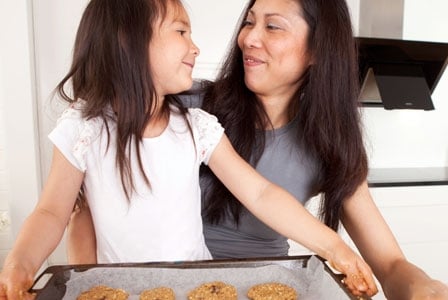
Getting your children involved in food preparation may encourage them to make healthier food choices.
According to news sources, a new Statistics Canada survey found that 31.5 percent of young people aged five to 17 are overweight or obese. These are troubling statistics, as childhood obesity has been linked to the development of diseases once only seen in adults, including type 2 diabetes, non-alcoholic fatty liver disease, and high blood pressure.
A possible solution
Although the issue of childhood obesity is complicated, recent research from the University of Alberta has revealed some interesting (and hopeful) findings. According to a province-wide survey of grade 5 students in 151 schools, children who helped out in the kitchen had a 10 percent higher preference for vegetables, and were more confident about the importance of making healthy food choices. According to lead study author Yen Li Chu, “These data show that encouraging kids to get involved in meal preparation could be an effective health promotion strategy for schools and parents.”
Chu also noted that there is great opportunity for schools to get involved, with activities such as healthy cooking classes and cooking clubs.
Getting your child involved
If you’d like to get your child more involved in and excited about meal preparation, the following tips may help:
- Start early: if your child still young—even two or three years old—this is the perfect time to get them interested in cooking.
- Try breakfast first: breakfast really is the most important meal of the day—and the easiest. Have your child decide the night before what she’ll have for breakfast, then get her to prep what she can. (For example, get out the bowl and the box of cereal and the banana. The next morning, she just has to add milk!)
- Gradually introduce more complex recipes: start with easy things such as pancakes, muffins, smoothies, and sandwiches, working up to more difficult recipes as time passes.
- Give your children age-appropriate tasks they can succeed at: perhaps asking your four-year-old child to dice the onion isn’t the best option. Get younger children to wash vegetables, tear lettuce, measure ingredients, and stir cold mixtures. Older children can practice carefully chopping items, opening cans, stirring items on the stove, grating cheese, and more.
- Take your child grocery shopping: explain which veggies and fruits are in season, and have him choose a few to incorporate into upcoming meals.
- Choose kid-friendly recipes: opt for simple and tasty recipes that kids can really get their heads around, such as Chicken with Peaches, green salad, Golden Tuna Melt, or Mini Personal Pizzas.
Taking it to the classroom
Many schools and teachers across the country are taking matters into their own hands to promote healthy eating among their students. To learn about these ground-breaking food revolution initiatives and to find out how you can create a successful food program in your child’s school, read “A food revolution in schools.”



